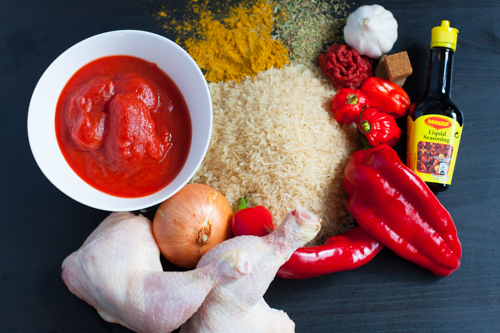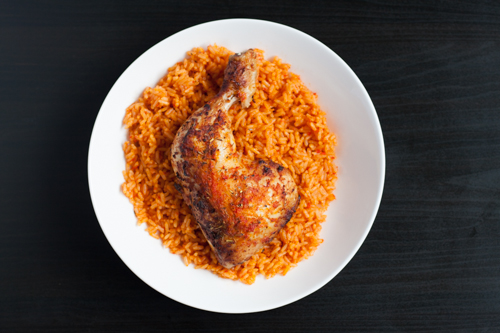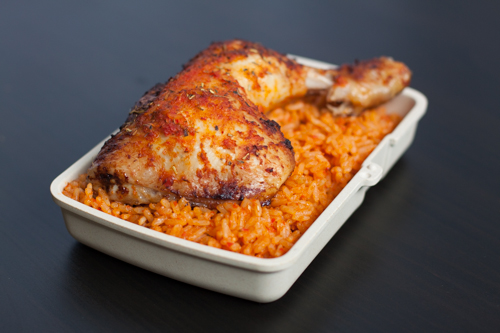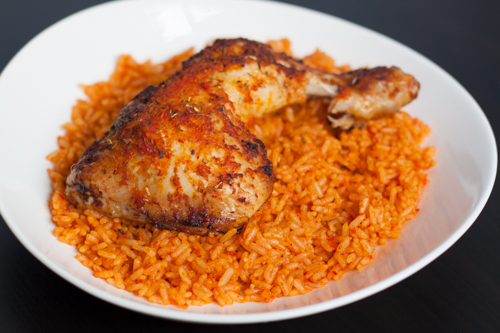Babatunde's jollof rice with chicken
 Thursday, July 7, 2016 at 10:14PM
Thursday, July 7, 2016 at 10:14PM 
I have an affinity for West African people. Whenever I find myself attracted to a person of African descent, they inevitably turn out to be (a) Nigerian or (b) Ghanaian. At the risk of making a sweeping generalisation based on the behaviour of 3 ex-partners, the downside of this is that they are near impossible to pin down for any kind of social arrangement. The upside is that when they finally do commit, there is bound to be jollof rice on the table. I can live with that.
Jollof rice is perhaps the most popular dish in West Africa. You will find it at every large social gathering and small ones too. In Nigeria, you can even get it as a side dish at KFC.
It is said to have originated in Senegambia and to be named after the Wolof tribe, but like any such claims when it comes to food, this is fiercely debated by other West African nations. I have heard a Ghanaian and a Nigerian argue for almost an hour about where jollof rice is really from and who makes it best (their mums, of course).
The recipe is almost as hotly contested as the origins and it varies from place to place. My friend Tunde, who is a British-born Nigerian, taught me this version. It’s his family recipe, which has been handed down the maternal line for generations. He was very secretive about it at first, but he soon changed his mind when I told him I was going to share the recipe on the Borough Market website.

Jollof rice is usually served as a side dish in a large spread alongside fried fish; meats, usually beef or chicken; and vegetable dishes, such as fried plantain. Tunde told me that the meat is often cooked in the same sauce as the rice, which gave me the idea of roasting the chicken in some of the sauce. It worked a treat.
I have used less oil in this recipe than Tunde does. It is still a lot, but it really is necessary in order to ensure the rice doesn’t clump together. For the same reason he recommends using a robust rice, like easy cook long grain. It will inevitably stick to the bottom of the pan though, so don’t use your favourite pot.
This recipe makes enough rice for a large family gathering so, if you're just making it for yourself, you’ll have enough for a week. Tunde told me that jollof rice always tastes better reheated the next day – and he’s right – so that’s fine by me.

Ingredients
1 red pepper, deseeded and roughly chopped
1 onion, roughly chopped
5 cloves garlic, roughly chopped
2 scotch bonnet chillies, roughly chopped (or to taste)
1 x 400g tin tomatoes
‘2 squirts’ (1 tbsp) tomato paste
100ml vegetable oil
1 vegetable stock cube
1 chicken stock cube
‘Few squirts’ (1 tsp) Maggi liquid seasoning, or to taste
Few pinches Caribbean hot curry powder
Few pinches Herbes de Provence
2 chicken legs
‘1 sieve full’ (approx. 500g) easy cook long grain rice
Method
Preheat the oven to 180C.
Put the pepper, onion, garlic, chillies, tinned tomatoes and tomato paste into a food processor, top up with water to cover and blend until smooth.
Heat the vegetable oil in a large saucepan over a medium heat. Add the blended mix and cook for a few minutes, stirring frequently.
Crumble the stock cubes into the sauce, then add the liquid seasoning, curry powder, a pinch or two of Herbes de Provence and stir to combine. Season with salt, to taste.
Put a spoon or two of the sauce on an oven tray and place the chicken legs on top. Put a few more spoons of sauce over the chicken legs. Sprinkle with a pinch of Herbes de Provence and salt, if desired. Put in the oven and bake for 30 minutes.
Meanwhile, rinse the rice until the water runs clear. Add to the saucepan with the sauce. The liquid should come to a few cm above the rice, if not top up with water as required. Turn the heat down to low and cover.
Cook covered for approx. 12 minutes, until most of the moisture has absorbed, then remove the cover and stir until the rest of the moisture has evaporated.
Remove from the heat and season with more salt, if required.

 Vix |
Vix |  6 Comments |
6 Comments | 
Reader Comments (6)
Hi there!
I've just stumbled by your blog via the SOAS alumni profile page. I'm about to embark on the MA in the Anthropology of Food and am so pleased to find somebody who actually delves into the subject on their blog!
I'm similarly obsessed with food, memory and the act of passing down recipes, and I also write about it on my own blog (tothetable.co.uk)
I love your I Am What I Eat series for Borough Market too – it's amazing how much you can learn about a person's sense of identity by asking them about their childhood memories of food.
Alice x
I don't think I have EVER eaten West African food, so this is a big hole in my culinary adventures - please cook this for me soon x
I impressed by the quality of information on this website. There are a lot of good resources here. I am sure I will visit this place again soon.
jorgefale xavyere e3d3fd1842 https://afroid.net/comprarepi
jorgefale xavyere e3d3fd1842 https://afroid.net/comprarepi
jorgefale xavyere e3d3fd1842 https://afroid.net/comprarepi